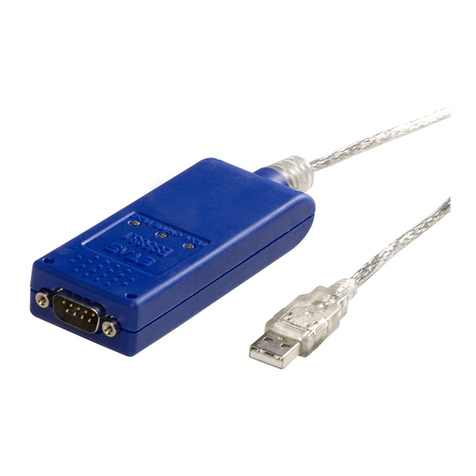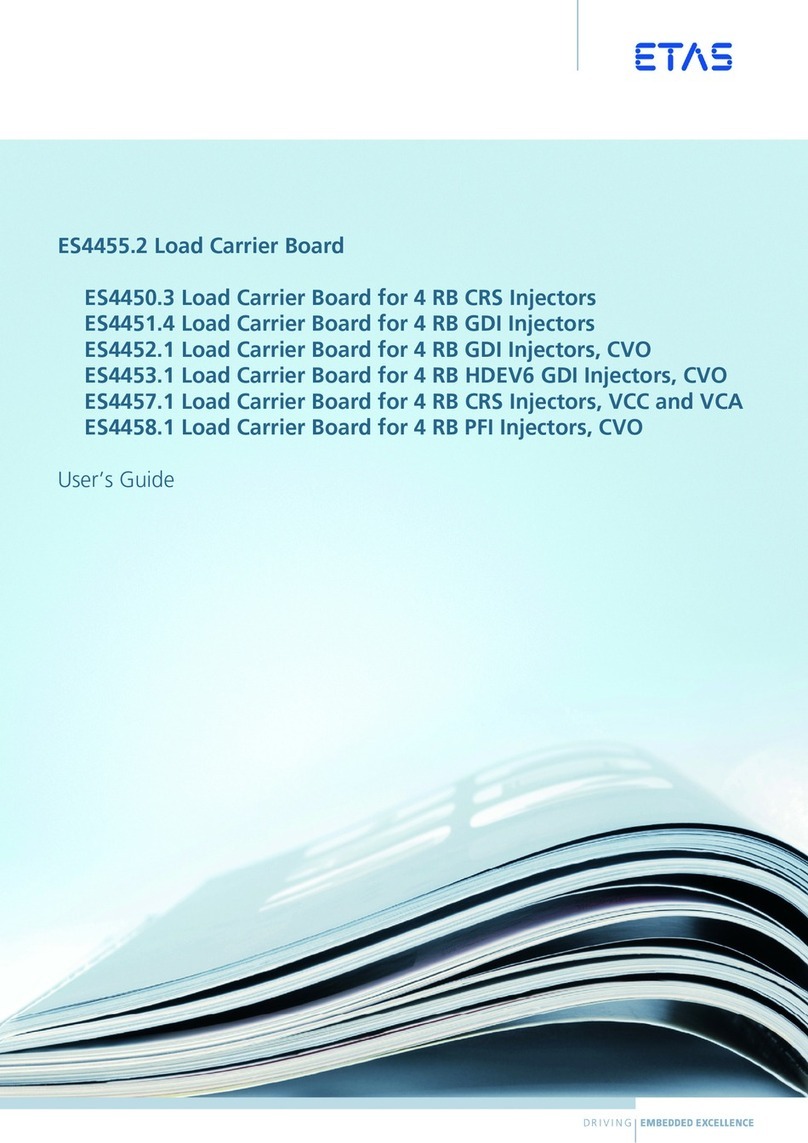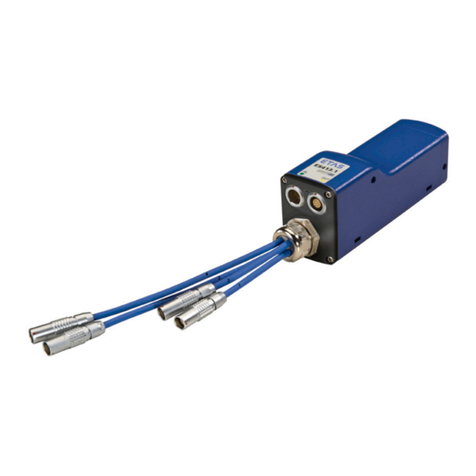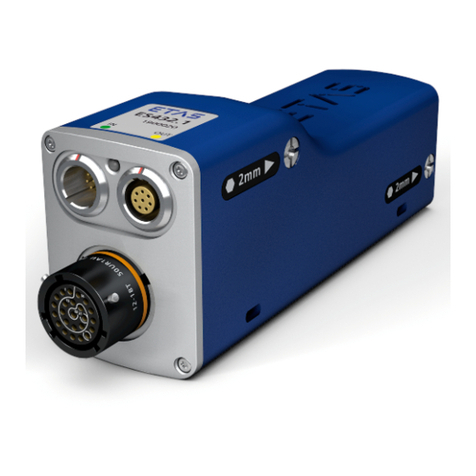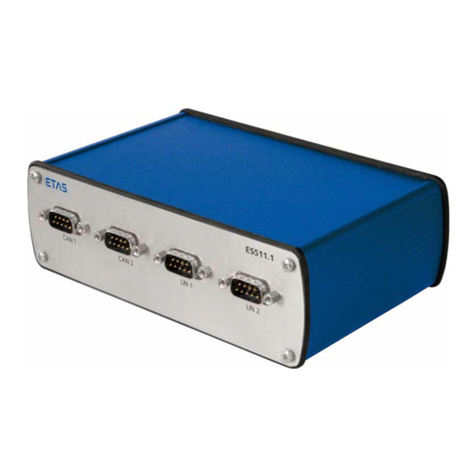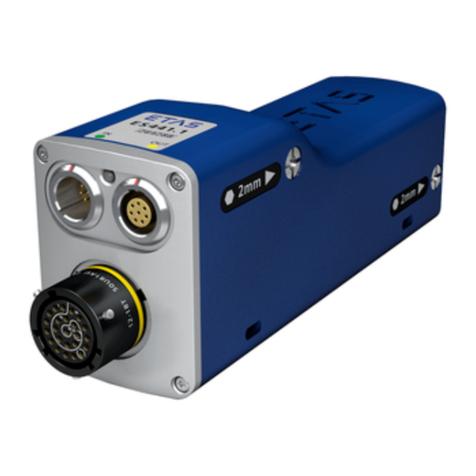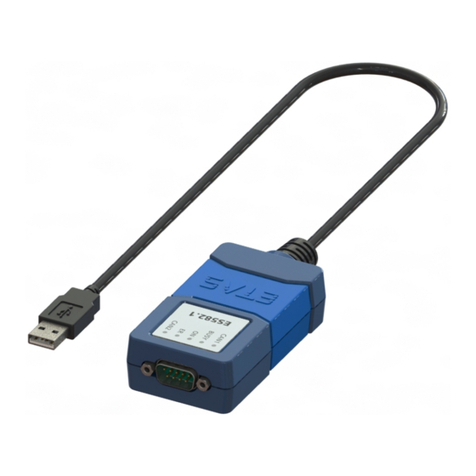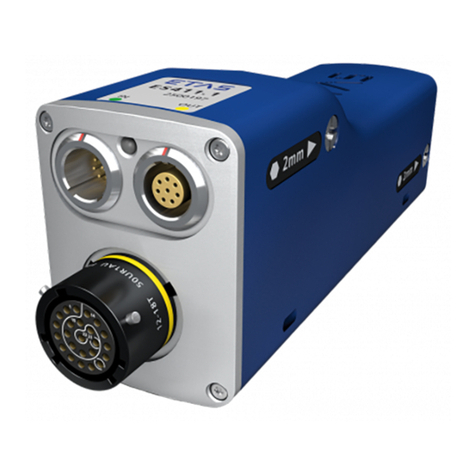
ES415.1 - User’s Guide 5
ETAS Contents
5.5.5 ES400 Modules with ETAS RTPRO-PC (Rapid Prototyping) . . . . . . . 57
5.6 Wiring . . . . . . . . . . . . . . . . . . . . . . . . . . . . . . . . . . . . . . . . . . . . . . . . . . . . 58
5.6.1 “Sensor” Port . . . . . . . . . . . . . . . . . . . . . . . . . . . . . . . . . . . . . . . . 58
5.6.2 Daisy Chain Ports (“IN”, “OUT”) . . . . . . . . . . . . . . . . . . . . . . . . . . 59
6 Troubleshooting Problems. . . . . . . . . . . . . . . . . . . . . . . . . . . . . . . . . . . . . . . . . . . 61
6.1 LED Displays . . . . . . . . . . . . . . . . . . . . . . . . . . . . . . . . . . . . . . . . . . . . . . . . 61
6.2 Troubleshooting ES415.1 Problems . . . . . . . . . . . . . . . . . . . . . . . . . . . . . . . 61
6.3 Problems and Solutions . . . . . . . . . . . . . . . . . . . . . . . . . . . . . . . . . . . . . . . . 64
6.3.1 Network Adapter Cannot Be Selected via Network Manager . . . . . 64
6.3.2 Search for Ethernet Hardware Fails . . . . . . . . . . . . . . . . . . . . . . . . 65
6.3.3 Personal Firewall Blocks Communication . . . . . . . . . . . . . . . . . . . . 67
7 Technical Data . . . . . . . . . . . . . . . . . . . . . . . . . . . . . . . . . . . . . . . . . . . . . . . . . . . 70
7.1 General Data . . . . . . . . . . . . . . . . . . . . . . . . . . . . . . . . . . . . . . . . . . . . . . . 70
7.1.1 Product labeling . . . . . . . . . . . . . . . . . . . . . . . . . . . . . . . . . . . . . . 70
7.1.2 Standards and Norms . . . . . . . . . . . . . . . . . . . . . . . . . . . . . . . . . . 71
7.1.3 Environmental Conditions . . . . . . . . . . . . . . . . . . . . . . . . . . . . . . 73
7.1.4 Maintenance the Product . . . . . . . . . . . . . . . . . . . . . . . . . . . . . . . 73
7.1.5 Cleaning the product. . . . . . . . . . . . . . . . . . . . . . . . . . . . . . . . . . . 73
7.1.6 Mechanical Data . . . . . . . . . . . . . . . . . . . . . . . . . . . . . . . . . . . . . . 73
7.1.7 Modules in one chain . . . . . . . . . . . . . . . . . . . . . . . . . . . . . . . . . . 73
7.2 RoHS conformity . . . . . . . . . . . . . . . . . . . . . . . . . . . . . . . . . . . . . . . . . . . . . 74
7.2.1 European Union . . . . . . . . . . . . . . . . . . . . . . . . . . . . . . . . . . . . . . 74
7.2.2 China . . . . . . . . . . . . . . . . . . . . . . . . . . . . . . . . . . . . . . . . . . . . . . 74
7.3 CE marking . . . . . . . . . . . . . . . . . . . . . . . . . . . . . . . . . . . . . . . . . . . . . . . . . 74
7.4 Product return and recycling . . . . . . . . . . . . . . . . . . . . . . . . . . . . . . . . . . . . 74
7.5 Declarable Substances . . . . . . . . . . . . . . . . . . . . . . . . . . . . . . . . . . . . . . . . 75
7.6 Use of Open Source software . . . . . . . . . . . . . . . . . . . . . . . . . . . . . . . . . . . 75
7.7 System Requirements . . . . . . . . . . . . . . . . . . . . . . . . . . . . . . . . . . . . . . . . . 75
7.7.1 Hardware . . . . . . . . . . . . . . . . . . . . . . . . . . . . . . . . . . . . . . . . . . . 75
7.7.2 Software . . . . . . . . . . . . . . . . . . . . . . . . . . . . . . . . . . . . . . . . . . . . 76
7.8 Electrical Data . . . . . . . . . . . . . . . . . . . . . . . . . . . . . . . . . . . . . . . . . . . . . . . 77
7.8.1 Host Interface ("IN" Connection) . . . . . . . . . . . . . . . . . . . . . . . . . 77
7.8.2 Power Supply . . . . . . . . . . . . . . . . . . . . . . . . . . . . . . . . . . . . . . . . 78
7.8.3 Sensor Power Supply . . . . . . . . . . . . . . . . . . . . . . . . . . . . . . . . . . . 78
7.8.4 Sensor Inputs . . . . . . . . . . . . . . . . . . . . . . . . . . . . . . . . . . . . . . . . 79
7.8.5 Signal Processing . . . . . . . . . . . . . . . . . . . . . . . . . . . . . . . . . . . . . 81
7.9 Pin Assignment . . . . . . . . . . . . . . . . . . . . . . . . . . . . . . . . . . . . . . . . . . . . . . 82
7.9.1 “IN” Connector. . . . . . . . . . . . . . . . . . . . . . . . . . . . . . . . . . . . . . . 82
7.9.2 “OUT” Connector . . . . . . . . . . . . . . . . . . . . . . . . . . . . . . . . . . . . . 83
7.9.3 “Sensor” Connector . . . . . . . . . . . . . . . . . . . . . . . . . . . . . . . . . . . 84
8 Cables and Accessories . . . . . . . . . . . . . . . . . . . . . . . . . . . . . . . . . . . . . . . . . . . . . 85
8.1 Combined Ethernet and Power Supply Cable . . . . . . . . . . . . . . . . . . . . . . . 86
8.1.1 Overview . . . . . . . . . . . . . . . . . . . . . . . . . . . . . . . . . . . . . . . . . . . . 86
8.1.2 CBEP410.1 Cable . . . . . . . . . . . . . . . . . . . . . . . . . . . . . . . . . . . . . 87
8.1.3 CBEP4105.1 Cable . . . . . . . . . . . . . . . . . . . . . . . . . . . . . . . . . . . . 87
8.1.4 CBEP415.1 Cable . . . . . . . . . . . . . . . . . . . . . . . . . . . . . . . . . . . . . 88
8.1.5 CBEP4155.1 Cable . . . . . . . . . . . . . . . . . . . . . . . . . . . . . . . . . . . . 88















